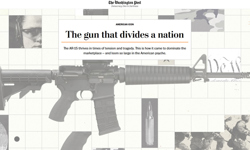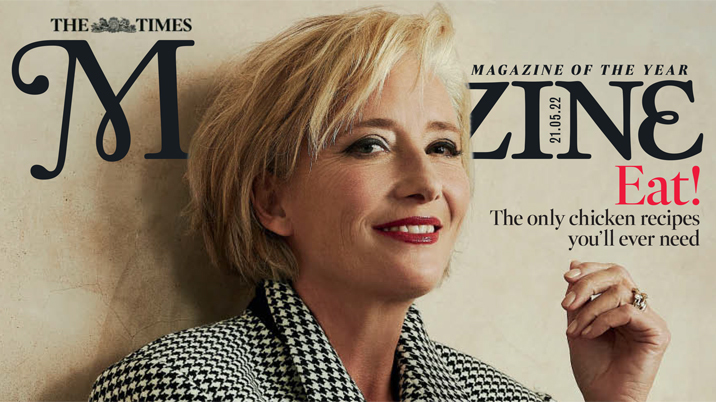
The age of a woman
A chap I know is dismissive of old people. “They’re terrible,” he says after another session with the Silver Threads or Golden Girls, for whom he helps to organise quizzes and lunches and afternoon teas. “They just want to play bingo or the raffle and eat their free lunch. When all the prizes are gone and there’s nothing more to be had, they lose interest.” The picture he paints is of a grasping generation. It isn’t pretty.
To be honest, it’s the picture I used to get from reading the Daily Express (slightly less so these days, under new ownership / editorship): a constant “we want OUR…” (fill in the dots with any right / privilege / tradition perceived to be under threat). The EU was trying to take away everything that was British – bring back our good old pounds and ounces (and pounds and shillings, while you’re at it); pensions weren’t rising fast enough; house price increases were a matter of joy, no matter what the impact on those still working for a living.
In both cases, there was an underlying feeling that pensioners are, or were, people to be patronised. And this encompassed not just one, but two and even three generations, since these unflattering sweeping generalisations and assumptions were applied to anyone old enough to have a bus pass.
When you’re a teenager or in your twenties, 60 seems desperately, unimaginably old. Your Mum and Dad aren’t “old”, of course. But you see them as the exceptions. It’s probably you who is keeping them youthful!
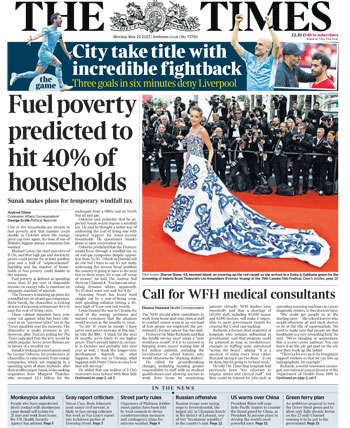
Candidates in The Apprentice tasked with inventing a new product for the over-60s come up with “Janet and John” style books to teach the wrinklies in the simplest terms what a cursor, mouse and alt key are – never for a moment pausing to think that the man sitting in judgment on them is not only of the target age group (Alan Sugar is actually 75), but also the man who pioneered home computing in this country.
What has set me musing on this? Our newspapers’ ongoing obsession with age (or specifically, women’s ages). Starting with The Times, which on Monday carried a front-page photograph of Sharon Stone wearing a gown with a long train on the red carpet at Cannes. The caption started: “Film trailer: Sharon Stone, 64…”
The previous Saturday, the key selling point for the Magazine was Emma Thompson’s new film. Both the front page and the magazine cover had the same line: “Why I’m going naked at 63”.
What about the men?
You might argue that the actor’s age was relevant in both cases – the new Stone film’s title translates to “Forever young”; and 63 is quite late for a debut stripping off. But is it the most urgent piece of information to be imparted? This past week has also seen Jamie Oliver, Kenneth Branagh and Tom Cruise gracing the Thunderer’s front page, yet no sub found it necessary to tell the readers how old they are (46, 61 and 59). I’d have thought it would be a mildly interesting fact, particularly given Branagh and Cruise’s latest roles, but caption space was too limited and I wouldn’t argue with that.
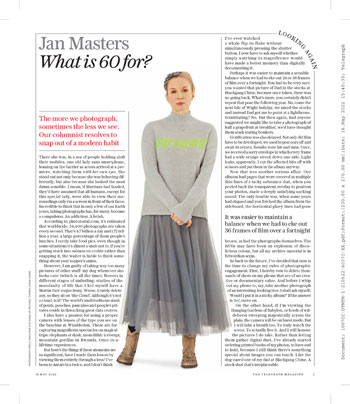
The Telegraph has meanwhile introduced a column in its Saturday magazine called “What is 60 for?” with a full length photo byline of Jan Masters (a different one every week) pointedly not looking the way we’re supposed to imagine 60-year-olds. It’s a readable enough feature – this week’s was about not living life through your phone camera, with a bit of reminiscence about sending film off to be developed and sticking the resultant blurry snaps into an album – but it’s going to be hard to sustain. If the idea is that 60 is a milestone and things are different, Masters is disproving it. If the idea is that 60 is a milestone and life is just the same as before, but with more memories and irritations, then that’s sort of commendable. But do Telegraph readers need to be told that?
The message in both the Times and Telegraph is about debunking stereotypes and showing that people (ideally, personable women) can still take on new challenges (and look good) when their contemporaries might be thinking of retirement. But we know that. Heavens, there have been enough “40 is the new 30”, “60 is the new 50” and “80 is the new 60” features across the whole spectrum.
(And of course the Mail is the champion of “Wow! Celeb looks great at 50, 60, 70…” But just as the paper deliberately looked the other way when photos of Lee Cain’s Downing Street farewell do emerged, so I am deliberately looking away from the Mail this week.)
What baffles me about this fascination with age (and it’s definitely a thing – I read the birthdays column to see how old people are and Richard Osman even produced a thin Radio 4 show based on panellists guessing celebrities’ ages) is the fact that the people overseeing these “gosh, fancy that” picture captions aren’t gauche young know-nothings like the Apprentice mob. John Witherow, the editor of the Times, is 70; Paul Dacre, uber-active editor-in-chief of the Mail titles, is 73. Do they see themselves (and their wives, partners, friends) as exceptions to the decrepitude of their cohort and that is therefore a matter of wonder that actors can still be glamorous as they grow older? And why is it that other editors who date-stamp every celeb who features in their pages are coy about revealing their own state of advancement when it comes to their public profiles?
Oh, and that chap at the top, setting quizzes for the old dears at Silver Threads? He’s 86.
News from America

From the first day in class or the reporter’s room to the last dinner party before meeting their maker, there is one question that every journalist will be asked to address: what is news? We all know the stock answers: man bites dog; anything that someone doesn’t want published; anything that makes people go “Gee whizz”. And most of us in the trade have a pretty clear sense of what will pique people’s interest, what is unusual, what readers need to know.
Where the question becomes more difficult is the hierarchy, our news values and priorities. With politics, there is always the agenda of the publisher to take into account – which is why it is more interesting when the Telegraph criticises the government than when the Guardian does. But what about one-off “hard news” stories? Human interest? Long-running sagas? Do we care more about the war in Ukraine than in Yemen because the victims are white Europeans “like us”, or because of the unique way this particular conflict threatens world stability? Western media would obviously insist the latter is the case.
That is a bit disingenuous. We all care more about things we can relate to. In its print days, The Independent was the bravest of the Fleet Street papers in putting overseas stories on its front page. It also suffered a sales dip every time it did so. The BBC has done a good job in reporting on the mistreatment of Uighurs in China and most of our nationals, including the redtops, have had a go at the story. But you’re unlikely to see them on any front page other than the Guardian. There just isn’t the public appetite for reading about these atrocities. When you’re just recovering from Covid, struggling to pay your electricity bill, and worrying about whether Putin is about to nuke you, other people’s misfortunes tend to take second place. Call it compassion fatigue or whatever, there’s only so much any brain can take.
School shootings
So, what sort of story would break through? I ask because I genuinely wondered whether the massacre of 19 American primary schoolchildren by a teenager would be enough. Television and radio news bulletins gave the killings prominence on Tuesday night and yesterday morning. But they are “instant” media, always looking for the latest event and, in the case of television, stories with strong visuals. What would the papers make of it, bearing in mind the time difference?
Obviously there is wider and deeper coverage today, but I was intrigued to discover the instinctive reactions to a breaking story that was neither political (for us at least) nor local - and the willingness or otherwise to junk the running order decided at afternoon conference.
Only the Times and Sun had the story on their first-edition fronts (The Sun as a pointer to a page 11 lead). The Telegraph and Guardian both changed their fronts to accommodate the story later (with a picture, in the case of the Guardian), while the Express and Star ran puffs for their second editions (to page leads on 17 and 2 respectively).
The Mail, Mirror, Metro and i all restricted coverage to inside. The one-edition i had only 67 words in its page 2 “News matrix”, the Mail promoted it between editions from the foot of page 2 to the top of 5, Metro put it on 13 and the Mirror on 19.
This last seemed out of character for a paper so concerned about the wellbeing of children. It was also intriguing to see that the Irish edition splashed on the shootings and the Ulster edition had it much further forward, on page 5.
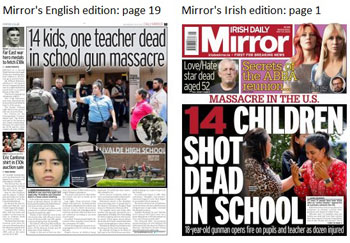
The other thing to note about the Mirror’s coverage is that the Irish edition did not carry a photograph of the killer – presumably in line with Jacinda Ardern’s thinking after the Christchurch killings that he should not be accorded the notoriety he craved – while the English and Ulster editions did.
(As a matter of interest, the Express, Star, Guardian, Telegraph all chose not to carry a picture of the gunman – for whatever reason. The i obviously didn’t, because it had only a nib. The Times, Sun and Metro had a mugshot and the Mail a full-length photograph of him holding a phone.)
The Times definitely led the way on this one, though, with a single on the front in the first, upgraded to splash and picture plus the lead foreign spread for the second.
But, as one headline put it, this was “another” school massacre. In another country. It’s hardly unusual: there have been 27 school shootings in America this year. Last year there were 34, the year before there were 10, and in 2018 and 2019 there were 24 apiece. What’s more, there have been just under 200 “mass shootings” in the US this year – the definition being where four or more people were shot, not necessarily fatally.
What is different here is both the number of victims – 14 and 1 teacher by the time the papers went to press on Tuesday, 19 and 2 by yesterday – and the fact that this was a primary school. Who could not fail to put themselves in the place of a parent who sent off a smiling seven-year-old to a place where you were confident that they would be happy and secure, never to see them again?
Long history
Most school shootings, going way back to 1840 when a student killed a law professor at the University of Virginia in Charlottesville, involve students with a grudge attacking people in their high schools or colleges. This has also been the case in other countries, including Germany, Finland and Canada. There have been higher death tolls in Nigeria and Kenya, but these often have terrorism links.
In America, what might be termed the current spate of shootings started with the Columbine massacre in 1999, when 12 students and a teacher were killed, and the most deadly was at Virginia Tech in 2007, when 32 students and staff were murdered. But the one everyone is relating back to is Sandy Hook in 2012, when a man aged 20 killed his mother before heading to the school and shooting dead 20 six- and seven-year-olds, four teachers, the principal and the school psychologist.
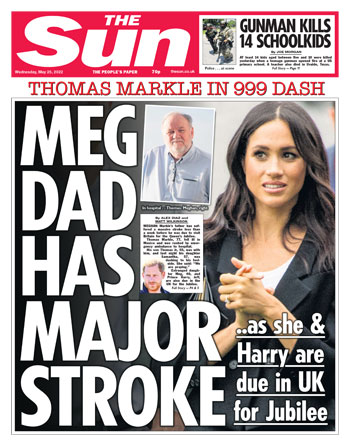
That was nearly a decade ago. So the mass murder of primary school children remains thankfully unusual, even in America.
You might have thought that that “rarity value”, coupled with our own memories of Dunblane with its similar toll in 1996, would have made it a Page One story for everyone. Yet most of the tabloids took the view that Meghan Markle’s father having a stroke was the bigger deal.
I do understand the obsession with Meghan (even if I don’t approve of where it’s coming from) and, hence, the interest in her father’s illness at the very moment our runaway royals are contemplating a trip back home. But was that really the big story to come out of America on Tuesday night? I think not.
The Star: no axe to grind
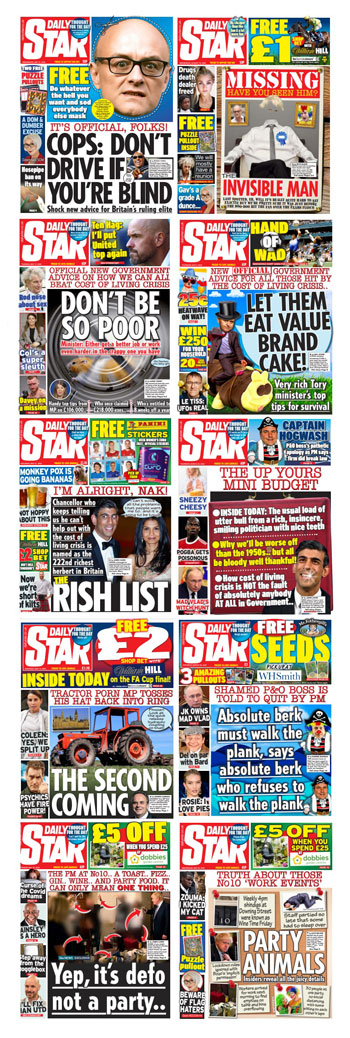
One of the titles to recognise that yesterday was the Daily Star, which ousted the cat-kicking footballer from the puffs to accommodate the news, which it ran in detail in its prime page 2 “serious” slot.
The Star is always worth looking at these days, since it is almost alone in having the capacity to judge every event on the day on its merits without being hidebound by its political allegiances or any particular societal agenda. At the height of the pandemic, it used ridicule as its main weapon of outrage at what it saw as governmental incompetence, calling ministers to account more effectively than almost any other news organisation. This week, it has been doing it again with the Downing Street party photographs and the testimony of people present.
All this interspersed with promises of a scorchio Jubilee weekend, the news that UFOs are real (well, yes, we’ve always known they’re real, we just don’t know what they are – hence the “unidentified” bit of “unidentified flying objects”), and a brilliantly risqué headline on the tractor porn MP thinking about standing for re-election.
And while you’d expect the Mirror to bang the Partygate drum for all its worth, the anti-Boris (and his gang) rants are coming from a Brexit-supporting, anti-woke paper that has absolutely no truck with snowflakes (abbreviated for headline purposes to “flakes”).
It’s also worth mentioning that the Star claimed in early March that Putin was seriously ill and scared of treatment. What looked then like a completely off-the-wall splash now seems to be common currency among Western intelligence organisations.
It also beat Private Eye to the joke when a British couple won £184m on the lottery. “That’s their energy bill covered for a few months then” ran its splash last Friday – while this week’s Eye has a cartoon captioned “We’re going to splash out on some hot water!”Time, I think to celebrate some of the paper’s greatest hits.

Predictable reactions to Sue Gray’s Partygate report

Meanwhile, Sue Gray has finally produced her Partygate report and we have had 24 hours of everyone acting out their prescribed script. A “contrite” prime minister told the Commons and his MPs that he was appalled by what went on, that lessons had been learned and that he took “full responsibility”, though it was unclear what that entails, since it clearly doesn’t involve the resignation demanded, as per script, by all the other party leaders.
The press, too, behaved as expected. This morning, the Star stuck with its comic cuts routine, digging out that Euros picture of the chap lighting a firework from his backside to signify the embarrassment of a “jackass PM” still in office. The Guardian and Mirror pick up on the derogatory treatment of cleaners and security staff, highlighting the vomiting, the altercation and the wine on the walls, while the three loyal tabloids go for the “time to move on” approach, playing down the boorish behaviour and instead using new photographs of the Prime Minister’s “birthday party” to illustrate what a minor infraction that was.
Both the Telegraph (which also has the birthday picture) and the Times give today’s expected cost-of-living package top billing – as the government clearly hoped. Hard to argue with that, since it will have more effect on people’s everyday lives than what Johnson and co got up to two years ago. The Times’s hamper, with its “Gray report vindicates me…” headline, seems to let Johnson off lightly. But in truth, it seems that report will change nothing and a delightful picture of a little girl with a certificate hours before she was shot by the Texas gunman is a better choice than yet another blurry shot of the Prime Minister holding a drink (in this case Coke) aloft.
The leader, however, is a damning indictment of the Johnson administration, concluding: “Again and again, the prime minister evades moral accountability and hides behind legalistic quibbling, heedless of the responsibilities and dignity of his office. It is a sorry tale that will breed cynicism and draw contempt.” But, as I say, it looks as though nothing is going to change. The Times knew all about Johnson’s character when it backed him for the Tory leadership and then urged the electorate to vote for him in 2019. It looks as though he has ridden this storm and will stay in office – and if he’s still there come the next election, the likelihood is that the Times will again tell readers to vote Conservative.
But back to the present and the last two little papers. This morning’s i cover is a lacklustre affair, with a portrait of Johnson and a headline “Failure of leadership” – which was the key line from Sue Gray’s update weeks ago. Did the paper see so little fresh meat in the full report that it couldn’t do better?
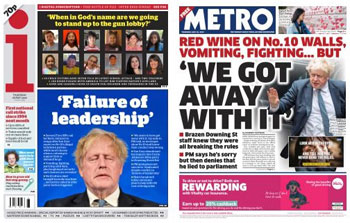
Metro certainly did, with the best (IMHO) front of the morning, picking up on one of those WhatsApp messages “We got away with it”. Because the most damning element of the report yesterday (given that Gray decided not to look into the party in the flat that appeared to be the clearest breach of the rules) was not the new photographs, the drunkenness or the disrespect of people doing their jobs, but the fact that those messages – “use the back door” and the like – showed that the people doing all this carousing knew full well that what they were doing was wrong. Metro understood this in a way that none of the others did.
Nothing to see here! Really?

So much for today’s coverage. After the marathon last time, I was determined not to labour the Partygate theme. But I would just like to highlight Tuesday’s Express and its “Nothing to see here!” splash on the Lee Cain leaving do pictures.
From the Mirror or Star, we would know that headline would be intended exactly as the phrase is usually used: “There’s lots to see here, but we don’t want you to look”.
But in the Express? Is it ridiculing the Met (which it quaintly calls “the Yard” as though we were still in the 1970s) for not seeing the evidence in front of it? Or maybe, given its ultra-loyalty to Johnson, it really is saying “move along” – the bit of the cliché missing from the head. The switch to “It’s ready! Rishi’s rescue plan for millions” yesterday and this morning’s “Is this what all the fuss is about?” suggests that is the more likely the case.
So, this was either very clever – and a trick missed by Johnson’s tabloid foes – or a sign that the paper is so out of touch that it didn’t realise what it was actually saying.
Front page of the fortnight
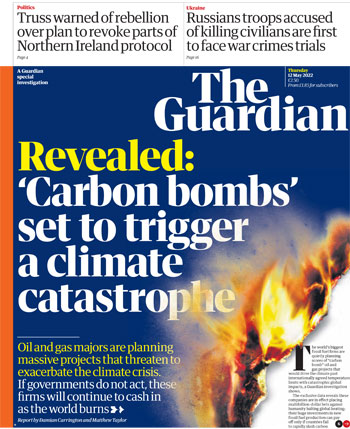
While everyone else was focused on the will-they-won’t-they Downing Street agonising over a windfall tax to mitigate the soaring cost of energy and rising household bills, the Guardian produced what was for me the most dramatic front page of the month.
Complemented by two inside spreads, it was the culmination of an investigation into how energy giants are working on fossil fuel projects that might worsen global warming – which, even with Putin destroying Ukraine, must surely be the biggest issue on the planet.
Needless to say, the story was not followed up by Fleet Street’s climate sceptics. Nor, sadly, even by those who do realise ‘Earth, we have a problem’.
We’d rather read about Wagatha Christie.
Liz Gerard’s Notebook is a fortnightly column published in the InPubWeekly newsletter. To be added to the mailing list, enter your email address here.







